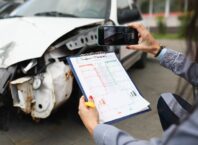Being involved in any type of car accident could have life-altering consequences — to both you and the other driver. But when you’re a victim of a hit-and-run accident, the experience is all-the-more traumatic.
The AAA Foundation for Traffic Safety states that these types of accidents account for as much as 13 percent of all traffic accidents across the U.S. This means that they’re not a rarity.
Every time you get in your car you are at risk, so it’s wise to know how to handle a car accident, especially a hit-and-run. Check out this informative guide for more.
Contents
What Classifies as a Hit-and-Run Accident?
The classification is simple: when one party involved in a collision flees the accident scene, this is considered a hit-and-run. It still counts if the accident is only a fender bender, too.
The reality is that there are severe consequences for leaving the scene of a collision, including criminal charges, jail time, and a huge monetary fine. If the consequences are so severe, why do people flee accident scenes anyway?
Some of the most common causes include a lack of auto insurance, a previous criminal record, being under the influence of alcohol or drugs, and non-ownership of the vehicle.
Whether your accident is severe or minor, it’s always wise to get in touch with a car accident lawyer to discuss your options and whether you have a solid case that’s worth filing.
Important Steps To Take After a Hit-and-Run
Granted, you may feel completely disoriented or overwhelmed after this type of accident. They tend to happen very quickly, and you may find yourself wondering what actually happened, especially if there is no other car at the scene.
If you or any other passenger in the vehicle is not gravely injured, there are a few crucial steps to take once you have gathered yourself after the accident. These steps are necessary to protect yourself, your passengers, and gain the compensation you deserve as the victim of a hit-and-run:
Step #1: Don’t Leave the Accident Scene
It’s important to stay calm after the accident and stay where you are. As angry or enraged as you may be with the other driver for fleeing the scene, don’t, under any circumstances, chase after them.
By staying at the scene, you have a chance to collect evidence about what happened, which can bolster your compensation case. It can also mitigate any penalties held against you for the accident itself.
Move your car off the road to safety and do a thorough check of yourself and passengers for injuries. If anyone is injured, call 911 right away.
Step #2: Always Call the Authorities
Once you have moved yourself to safety and called 911 for medical assistance (if needed), it’s important to call your local authorities. In some states, it’s actually a legal requirement to do so after a hit-and-run collision.
Just to be safe, no matter what state you live in, call the police. Once they arrive at the scene they can help you gather evidence, investigate the incident further, and file an accurate report.
Step #3: Gather and Retain as Much Detail as Possible
If you can remember anything about how the accident happened — the make of the vehicle, its color, or even the license plate number, write it down then and there. Even if you’re in a state of shock, your memory will be its clearest at the scene of the accident.
You also want to take photos of the accident scene, your car, and any injuries you or passengers might have sustained. Take close-up photos of scratches, dents, and dings, your injuries. Anything you can remember, no matter how small the detail is, can help you when it comes time to file an insurance claim.
Step #4: Locate Witnesses
Most car accidents tend to draw some kind of attention. If you’re lucky enough, there could be a few people who may have actually seen what happened. They may also have more detail about the other driver’s car, license plate number, etc.
Try and locate any witnesses who are willing to help you with information. If possible, take down their names and contact information so that you can contact them for further information when needs be.
Step #5: Get in Touch With Your Insurance
It’s super important to contact your insurance company as soon as you can after the accident. This way, you have a better chance of filing the accident early, and processing it all while your memory of what happened is still fairly clear.
They will also walk you through all the necessary steps to take to file a successful claim.
Legal Requirements and Consequences of a Hit-and-Run
If you’re ever involved in a car accident and you are to blame for it, this is what you are legally required to do after it takes place:
- Move your vehicle to a safe location, where possible
- You should then check yourself and passengers for injury
- You should then exit your vehicle and check on the passengers in the other vehicle
- It’s then important to check if anyone else nearby sustained an injury due to the accident
- If anyone requires medical attention, it’s on you to call emergency services
If you don’t follow these steps and choose to flee the scene for whatever reason, you could face some serious consequences. The penalties vary depending on the severity of the accident, whether anyone was injured or killed, and your mental state at the time.
They range from driver’s license suspension, large monetary fines (up to $20,000 in some cases), criminal charges of culpable homicide, and prison time of up to 15-years.
Does Insurance Cover a Hit-and-Run Accident?
If you’re the victim in a hit-and-run and the police find and identify the culprit, there’s a good chance that their insurance company would have to pay for your damages.
But the reality is that many hit-and-run drivers are never actually found. This means that their liability coverage is not an option for your financial compensation. But this doesn’t mean you can’t claim financial assistance from your own insurance company.
The amount of coverage you receive depends on the policy you have and what it covers. Some of the most common forms of insurance coverage that support hit-and-run compensation include:
Collision Coverage
This is the very basic type of insurance that assists with covering the costs of repairing or replacing your car after an accident. Bear in mind that you may still be required to pay a deductible for this type of cover. This is usually a fixed amount as specified in your policy.
Uninsured Motorist Property Damage
This form of insurance is a little more robust. It covers the cost of the repair or replacement of your vehicle if the culprit has limited or non-existent insurance.
The great thing about this type of coverage is that you’re also covered if a hit-and-run driver is unidentified. But this type of cover does vary from state-to-state. In some states, you may only be covered for one, or the other, but not both.
Depending on the state, it’s a mandatory requirement to take out this type of insurance coverage. If the plan is not robust enough for you, it may be worth taking out additional collision coverage, too.
Uninsured Motorist Bodily Injury Protection
This type of insurance cover is similar to the above, except that it assists in paying for your injuries, and those of your passengers. If you are hit by a motorist with limited or no insurance cover, you can expect to be covered for medical costs, loss of income, and pain and suffering.
This is also a type of insurance that is mandatory in many states. Whereas in no-fault states, you can file a claim with your insurance company regardless of who is at fault and receive some form of compensation.
Regardless of how careful you are on the road, it’s also a good idea to have uninsured and underinsured coverage. You never know what could come your way and the reality is that the other driver usually doesn’t have sufficient insurance.
Your best bet is to protect yourself where you can if you’re the owner of a vehicle.
Compensation Entitlement
Once you’re the victim of a hit-and-run, you are entitled to a certain amount of compensation, regardless of your insurance coverage. If you hire a car accident lawyer to fight your case, they will do their best to fight for one of two types of compensation, or both:
Economic: this covers expenditure as a result of the crash — whether current or in the future. These costs could include car repair bills, loss of income, medical bills, and physical therapy costs.
Non-economic: this covers intangible costs as a result of the crash, such as your pain and suffering. You might have suffered the loss of a friend or loved one, or some form of trauma. Bear in mind that an experienced attorney is important for this process as it can be very complicated.
Looking To Learn More About the Law?
No one wants to be the victim of a hit-and-run accident, but sometimes bad things happen to even the best people. Whenever you hit the road, you’re taking a risk — not because you’re a bad driver, but you never know how the actions of others could affect you.
You can never be too prepared. So if you’re looking to learn more about personal injury or car accident compensation and all the legal requirements, explore this site for more!












